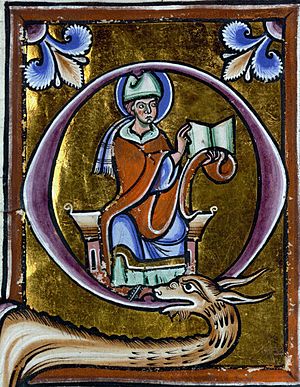Gilbert de la Porrée facts for kids
Quick facts for kids
Gilbert de la Porrée
|
|
|---|---|

Gilbert de La Porrée holding an opened book, anonymous, XIIth century.
|
|
| Born | 1070 |
| Died | 4 September 1154 |
| Occupation | Writer |
Gilbert de la Porrée (born after 1085 – died 4 September 1154) was an important thinker and teacher from the Middle Ages. He was also known as Gilbert of Poitiers. He was a scholastic (a type of philosopher and teacher), a logician (someone who studies reasoning), and a theologian (someone who studies religion). He also became a Bishop in the city of Poitiers.
Contents
Gilbert's Early Life and Education
Gilbert de la Porrée was born in Poitiers, a city in France. He started his studies there. He then went to Chartres, where he learned from a famous teacher named Bernard of Chartres. At Chartres, Gilbert studied the ideas of two ancient Greek philosophers, Aristotle and Plato.
Later, he continued his education in Laon, where he studied the Bible under Anselm of Laon and Ralph of Laon. After finishing his studies, Gilbert returned to Poitiers, where people believe he began teaching.
Teaching Career and Popularity
Gilbert later went back to Chartres to teach logic and theology. He took over from Bernard of Chartres as the Chancellor (a high-ranking official) from 1126 to 1140. He also gave lectures in Paris, which were very popular.
A writer named Everard, who was a Cistercian monk, wrote that Gilbert was much more popular in Paris than in Chartres. Everard said he was only the fourth person to attend Gilbert's lectures in Chartres, but he was the three hundredth person to attend in Paris!
One of Gilbert's students in Paris in 1141 was John of Salisbury. John was greatly influenced by Gilbert's teaching. John later became Chancellor of Chartres himself. He wrote that Gilbert taught grammar and theology. Gilbert was a strict teacher; he would even punish students for grammatical mistakes. If he thought a student was wasting time, he would suggest they try bread making instead! When Gilbert lectured, he used ideas from philosophers, speakers, and poets to help explain things.
Gilbert's Ideas and Challenges
In the 1140s, Gilbert published a book called Commentary on Boethius's Opuscula Sacra. This book was meant to explain the ideas of an earlier philosopher named Boethius. However, Gilbert's interpretation of the Holy Trinity (a key Christian belief about God) was seen as different from what the Church taught.
Becoming a Bishop and Facing Accusations
In 1142, Gilbert became the Bishop of Poitiers. In the same year, two church officials, Arnaud and Calon, accused him of having wrong ideas about the Trinity. Also in 1142, someone else took over Gilbert's teaching job in Chartres.
By 1147, another important theologian, Peter Lombard, criticized Gilbert's ideas about the Trinity in Paris.
The Trial of Gilbert de la Porrée
In 1148, Bernard of Clairvaux, a very influential saint known for finding and correcting wrong beliefs, brought Gilbert to trial. Saint Bernard had suspected Gilbert's ideas before. This was because the school of Chartres, where Gilbert was Chancellor, had supported another thinker named Abelard, who had also been accused of wrong ideas.
Pope Eugene III led the trial. Both Gilbert and Bernard were asked to explain specific parts of the Bible. Bernard, who was not as experienced in the detailed arguments used in schools, found it hard to prove Gilbert was wrong. However, it was decided that Gilbert had to change some parts of his book to match the Church's teachings.
Later Life and Legacy
Gilbert de la Porrée died in 1154. He was buried in the Église Saint-Hilaire-le-Grand in Poitiers. His work and the discussions around his ideas were important in the history of philosophy and theology during the Middle Ages.
See also
 In Spanish: Gilberto Porretano para niños
In Spanish: Gilberto Porretano para niños

